Building an amazing desktop computer is easy, but even after you stuff your new system with the latest hardware, hook up your cabling, and make room for your giant monitor, you’re not quite done. Make it easy on the eyes with this handy guide.
Building a desktop computer that’s amazing is easy, if a little time-consuming. But even after you’ve stuffed your new system with all the latest hardware, hooked up your cabling, and cleaned off your desk for a giant monitor, you’re not quite done.
Your new desktop masterpiece is going to do you little good if you can use it for only a few hours each day. And you have the failure of your own biology to thank for that: Humans were made to be hunters, gatherers, and thinkers, not desk jockeys.
Spend too much time in front of your screen, and you’re going to wreck your eyes—and no, we’re not just channeling our worried mothers. Computer Vision Syndrome (CVS) is a real condition with real symptoms that you’ve likely already noticed at some point in your tech-centric life: bloodshot peepers staring at you in the mirror after a long day of gaming; the tired, dry feelings that you attempt to relieve by rubbing your eyes; or perhaps a bit of burning, itching, or increased sensitivity to light.
There are plenty of ways to keep your eyes from rioting every time you fire up your favorite Web browser. Most of them are super-easy to set up and require more time than money, although fancier (and pricier) solutions can give you a beautiful desktop setup and happier eyeballs all at once. In any case, your eyes will forever thank you for your investment.
Basic Lighting
While you might think that you’re looking at a crisper, more pleasing picture in a dim or otherwise darker environment, you’re just forcing your eyes to work that much harder to process extreme differences in contrast. And a similar situation happens when you set up your screen in a location that creates a ton of glare: not only does your picture look horrible, but all that light mucks up the quality of your picture and forces your eyes to do a lot more refocusing to achieve better clarity.
So if you’re sitting at a computer under fluorescent lights and you aren’t at work, just stop: This kind of overhead lighting is one of the harshest environments for your eyes to deal with.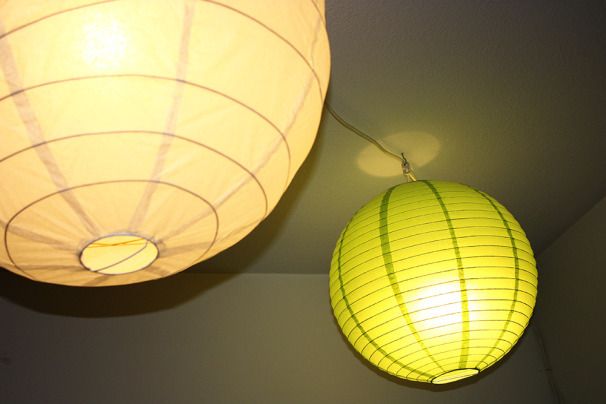
The best setup? Plain ol’ natural light, best deployed in the form of a window angled perpendicular to your computer screen. You might be tempted to slap your monitor or laptop in front of a huge window to enjoy some scenery while you work, but the brightness of your exterior view could stress your eyes out. You could always use blinds or curtains to limit the amount of light coming in when it’s especially bothersome, but that kind of defeats the point of the view, doesn’t it?
When placing your screen perpendicular to your natural light source, you want to make sure that you’re balancing ambience with glare reduction: Angle your display so that extra light isn’t bouncing off your screen. And take some time to play around with your PC setup; a few minutes now will save you countless hours of agony later. Again, blinds or curtains can be an eye-saving device if the sun is really giving you trouble during certain hours of the day.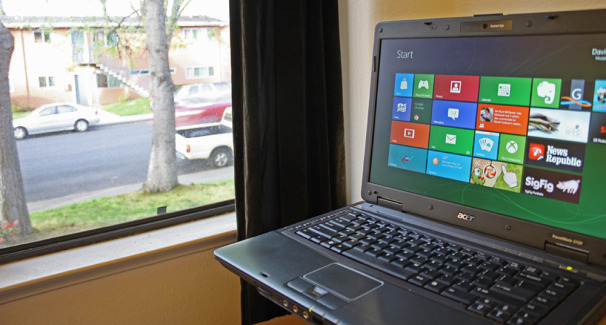
You’ll want to supplement this natural light (or lack thereof, as the day turns to evening) with artificial lighting. And overhead lighting—even incandescent—still isn’t the best option due to its potential for glare. But you shouldn’t go to the other extreme, either. Resist the urge to purchase the classic “spotlight” desk lamp and slap its narrow cone of light somewhere on your desktop. Remember, you’re also trying to avoid sharp differences in contrast.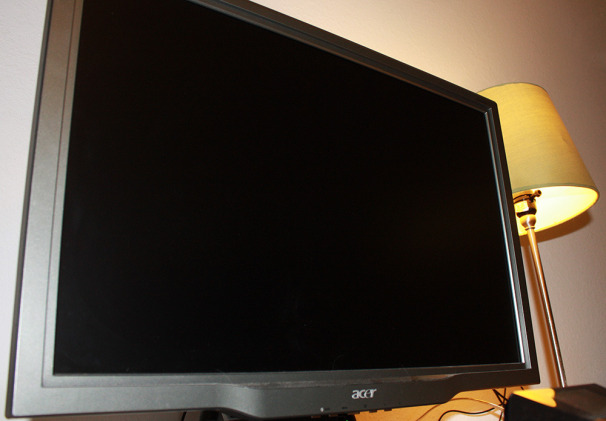
You don’t need that much light around a monitor or laptop screen, and what you pick needs only to supply indirect light in a general area around your desk and display. A small lamp on a desk that creates a pleasant diffusion of light behind your display and prevents glare is great; a full-sized floor lamp can also work wonders, provided it physically fits into your particular desk setup. As for bulbs, consider those of the natural light (and low wattage) variety: If you need more brightness, switch to higher wattages or add another light source.
Advanced Lighting
If you’re looking for a setup that looks a little bit cooler than a tiny lamp on your desk—or if your particular desktop setup has no room for any bulkier lighting equipment—you might want to consider trying out some bias lighting.
You’ve probably seen the concept before, likely on a Philips HDTV with ambient lighting (or as Philips brands it, “Ambilight”). The gist is simple: LED lights attached to the rear of your monitor blast the background with colored light (desktop systems only—unless you really want to silly up your laptop), helping to reduce glare in dimly lit environments, to make your picture appear sharper, and to transform your boring ol’ monitor into a glowing beacon of cool.
As Sound and Vision’s Timothy Seppala describes the benefits of bias lighting, in an interview with Ars Technica, “It works because it provides enough ambient light in the viewing area that your pupils don’t have to dilate as far. This makes for less eyestrain when a flashbang gets thrown your way or a bolt of lightning streams across the screen.” Tim actually wrote a great guide to getting the most out of your HDTV for PCWorld that includes some tips on lighting your home theater for optimal movie watching, and you should definitely check it out if you’re a serious PC enthusiast seeking to optimize your display.
When it comes to PC building, though, the problem with bias lighting is that few devices and software combinations exist that will allow you to achieve the perfect setup: ambient lighting that changes to match the colors appearing on your screen. We’ve had a lot of luck with Mad Catz’s Cyborg Gaming Lights. They’re a bit pricy at $100, but you get two little lighting modules that contain three LEDs (red, green, and blue) for creating any color you’re looking at.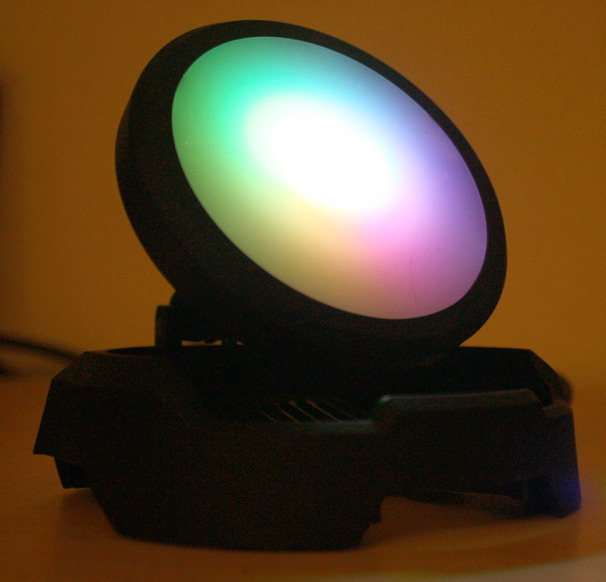
You just need to plug the lights into two of your system’s free USB ports (after plugging the lights’ power adapter into the wall), stash them behind your monitor, angle the lights up toward the wall, and fire up a software utility. You can then pick the color that you want to live behind your screen or set your lights to slowly rotate through a series of colors. You can also have the lights dynamically switch their appearance based on whatever happens to be on your screen—be it a game, a movie, or a picture.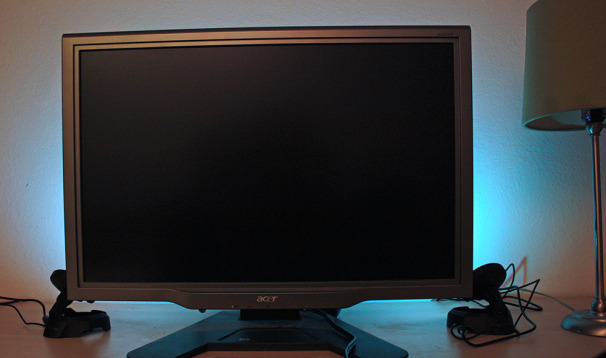
If you’re looking for a more inexpensive way to build bias lighting into your desktop monitor, you can always pick up Antec’s Halo 6 LED Bias Lighting Kit. For a mere $13, you can slap a strip of six white LEDs to the rear of your display. These lights—or a similar style that you can pick up at your local IKEA (Ledberg or Dioder)—aren’t going to modulate to fit whatever’s on your screen. But at least you’ll be able to reap the benefits of bias lighting without breaking your bank account.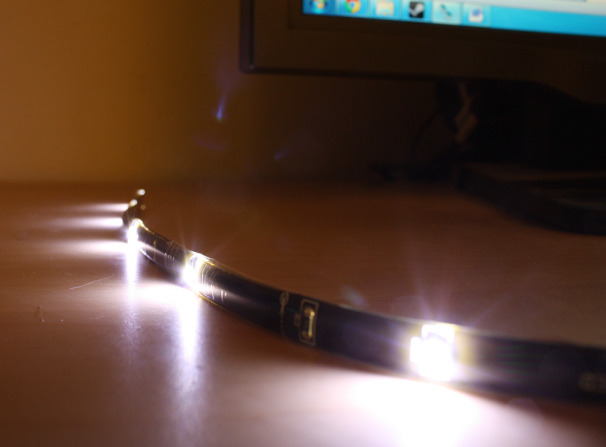
A bias lighting strip that you would attach to the rear of your display.
Beyond Lighting
Other tricks you can employ to reduce the harmful effects of extended computer use on your eyeballs include installing little apps to remind yourself to take a much-needed eye break. Chrome users can grab the extension Gimme a Break! and Firefox fans can hit up the simple Auto Timer extension to schedule some rest time for tired eyeballs. For every 20 minutes you spend staring at a screen, you need only to focus your eyes on something else for 20 seconds—that’s not so hard, is it?
The software fun doesn’t end there. Odds are good that you’re running your display at fairly high brightness and contrast levels, as monitors are sometimes shipped with factory-default settings that use inordinate amounts of brightness to convince you that the picture is awesome. Not good. You’ll want to fire up the Lagom LCD monitor test pages and use their instructions to set your monitor’s settings to their correct levels. Why blast your eyes with excessively bright light if you don’t have to?
Your monitor’s color temperature can also adversely affect your eyes after prolonged periods of staring. An app like F.Lux (click on the Download link at the top of the site) will automatically adjust your monitor’s temperature to match the time: Cooler lighting during the day, mimicking the temperature of common daylight, and warmer lighting in the evening, when “you probably shouldn’t be looking at the sun,” says F.Lux.
Finally, you can also opt for a pair of geektastic computer glasses to help you handle your display temperature situation and reduce screen glare—we’re speaking specifically of Gunnar Optiks’ line of Advanced Computer Eyeware (the company’s term, not ours).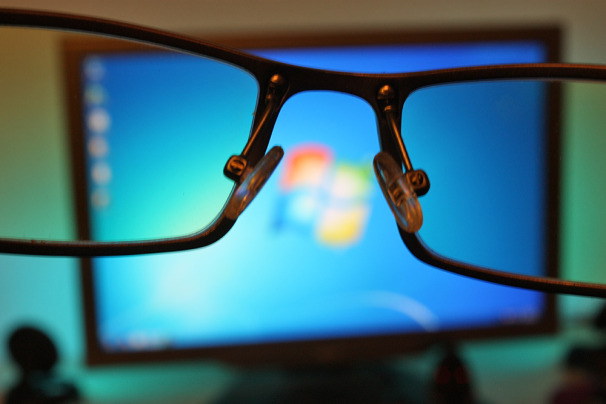
Gunnar Optiks claims that its glasses also help increase the moisture within your eyes—a function commonly performed by blinking, which one tends to do much less when focusing on a computer screen. We can’t say whether Gunnar’s glasses turn eyeballs into swimming pools, but we did tend to notice less eye fatigue (and didn’t seem to have the same headaches as before) after a few marathon computing sessions when equipped with its glasses. Their yellow tint does take some getting used to, however!
Important Notice: Tweet this article with the bookmark social media share below to stand a chance to win an ipad or start making money with your twitter account (it works only with your twitter account and the more articles you tweet the more you stand a chance to win an Ipad)